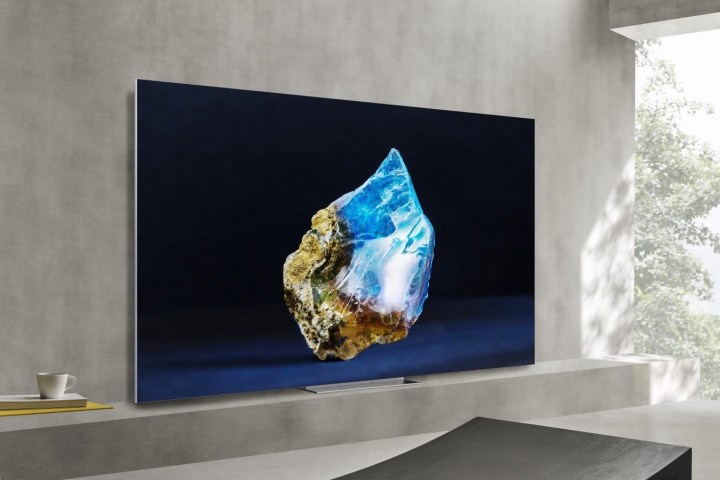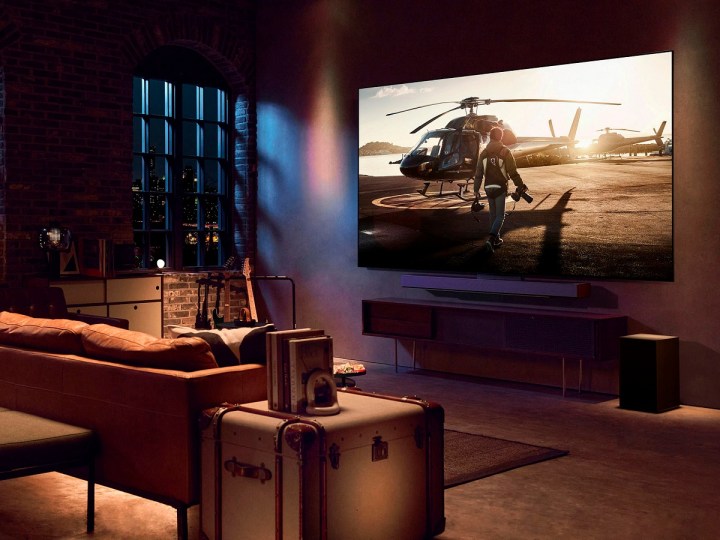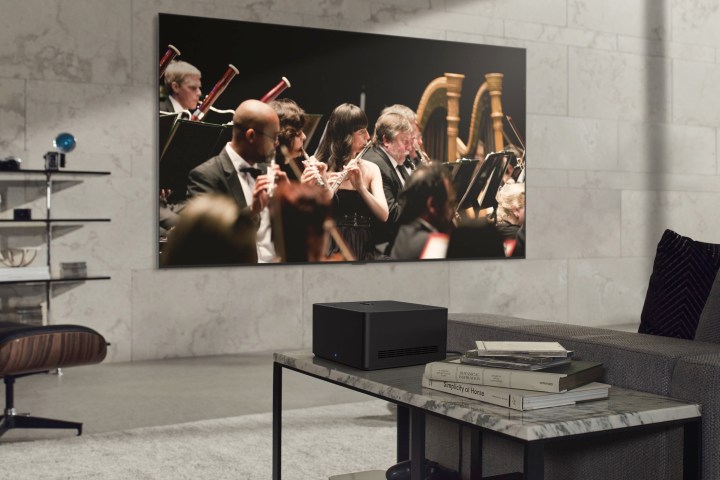
The world of TVs is all about acronyms. You see them all over the place you store for units from the likes of Samsung, LG, TCL, Sony, and others, and these are crucial three-, four-, and five-letter codewords to decipher. For probably the most half, we’re all accustomed to acronyms like HD and 4K, however once we begin throwing round letter pairings like OLED, LED, QLED, and now QD-OLED, issues can get complicated in a short time. To not fear although, we’re right here to assist.
The examples above are all simply totally different lighting and show applied sciences that TV firms use to get an image in your TV display. Right this moment, we’ll concentrate on evaluating two of the most well-liked show applied sciences: OLED and LED. The previous stands for “natural light-emitting diode,” and the latter stands for “light-emitting diode”. Whereas these two TV varieties could look comparable on the shelf, they couldn’t be extra totally different with regards to how every set produces an image, and the way colourful or vibrant that image will be.
For those who’re available in the market for a brand new TV, we’ve additionally rounded up the perfect 4K TV offers and the perfect OLED TV gross sales obtainable.
What does LED imply?

Non-OLED TVs are manufactured from two major elements: an LCD panel and a backlight. The LCD panel accommodates the pixels, the little coloured dots that make up a TV’s picture. On their very own, pixels can’t be seen; they require a backlight. When mild from the backlight shines by an LCD pixel, you’ll be able to see its coloration.
The “LED” in LED TV merely refers to how the backlight is made. Up to now, a thicker and fewer environment friendly expertise known as CCFL (cold-cathode fluorescent mild) was used. However nowadays, nearly each flat-screen TV (sans OLED) makes use of LEDs as its supply of backlighting. Thus, whenever you see the time period “LED TV,” it merely refers to an LED-backlit LCD TV.
That stated, not all LED TVs are created equal. There will be variations within the quantity and high quality of the LEDs used, which results in variations in issues like brightness and black ranges. As an illustration, you’ve most likely heard of QLED TVs. It is a sort of LED TV that makes use of quantum dots to attain higher brightness and coloration. We’ll talk about QLED extra under, however right here’s an ideal overview of the variations between QLED and OLED TVs.
What does OLED imply?

As talked about, the “OLED” in OLED TV stands for “natural light-emitting diode.” OLEDs have the bizarre property of with the ability to produce each mild and coloration from a single diode once they’re fed electrical energy. Due to this, OLED TVs don’t want a separate backlight. Every pixel you see is a self-contained supply of coloration and light-weight.
A number of the inherent advantages of OLED screens are that they are often extraordinarily skinny and versatile. However the largest profit once we examine them to LED TVs is that every particular person pixel receives its personal luminance and energy (versus LED TVs, which have persistent pixels that require an exterior supply of sunshine to see). When it’s on, you’ll be able to see it. When it’s off, it emits no mild in any respect — it’s utterly black. We’ll talk about how this impacts black ranges in a second.
At present, LG Show, famed for top-line LG OLEDs just like the G3 Collection, is the one producer of OLED panels for TVs. And because of partnerships between LG Show and types like Samsung and Sony, you’ll be capable of purchase Samsung and Sony OLEDs, such because the Samsung S95C and Sony A95L. Whereas these fashions nonetheless use picture-processing instruments developed by every respective firm, the OLED panels are from LG Show.
Is QLED the identical as OLED?

Whereas these pesky acronyms could sound comparable, an OLED TV isn’t the identical as a QLED TV. In actual fact, these two varieties of TVs couldn’t be extra totally different. Bear in mind how OLED TVs are able to producing mild and coloration with out precise backlighting? Nicely, it’s precisely the alternative for QLED units.
QLEDs are literally most much like conventional LED-LCD TVs. The one distinction is that QLEDS embody a layer of quantum dots between the backlight and the show. When mild passes by these chemical blots, the sunshine supply is enhanced earlier than hitting the again of the TV display. And by enhanced, we imply a brighter and way more colourful image than you’d get on a non-QLED LCD display.
However what about QD-OLEDs?
These days, there’s truly an image expertise that mixes the perfect of QLED lighting and quantum dots with natural, self-emissive pixels. These TVs are known as QD-OLEDs, and so they’re presently made by each Samsung and Sony. With out diving into the true nitty-gritty of the image tech, we are able to consider a QD-OLED as a conventional OLED infused with quantum dots. The tip results of a majority of these shows is a TV that may obtain deep colours and distinction, in addition to superior brightness.
Which is best, OLED TV or LED TV?

Now it’s time to pit these two applied sciences towards one another and see how they stack up with regards to standards like colours, distinction, viewing angle, brightness, and different efficiency concerns.
Editor’s observe: Since OLED TVs are nonetheless a premium show, we’ve got in contrast OLED solely to equally premium LED TVs armed with comparable efficiency potential (besides, in fact, within the value part).
Black degree
A show’s means to supply deep, inky blacks is arguably crucial think about reaching glorious image high quality. Deeper blacks permit for increased distinction and richer colours (amongst different issues) and thus a extra practical and dazzling picture. In relation to black ranges, OLED reigns because the undisputed champion.
LED TVs depend on LED backlights shining behind an LCD panel. Even with superior dimming expertise, which selectively dims LEDs that don’t have to be on at full blast, LED TVs have traditionally struggled to supply stable black ranges and may endure from an impact known as “mild bleed,” the place lighter sections of the display create a haze or bloom in adjoining darker areas.
OLED TVs endure from not one of the black-level issues of conventional LED TVs. If an OLED pixel isn’t getting electrical energy, it doesn’t produce any mild and is, subsequently, completely black. Seems like an apparent option to us.
Winner: OLED TV
Brightness
In relation to brightness, LED TVs have a substantial benefit. Their backlights will be comprised of giant and highly effective LEDs. With the addition of quantum dots, that brightness will be preserved whilst the scale of the person LEDs will get smaller. OLED TVs can get fairly vibrant, too, and with such darkish black ranges, the distinction between the brightest and darkest spots on the display is all of the extra exaggerated. However cranking OLED pixels to their most brightness for prolonged intervals reduces their lifespan, and the pixel takes barely longer to return to whole black.
With these concerns in thoughts, it’s vital to notice that every one fashionable TVs — whether or not OLED, LED, or QLED — produce greater than satisfactory brightness. The consideration then turns into the place the TV can be used. In a darkish room, an OLED TV goes to carry out greatest, whereas LED TVs will outshine them (fairly actually) in additional brightly lit environments.
It must also be famous that there have been massive positive aspects not too long ago in OLED brightness, making them completely appropriate for practically any state of affairs, save for direct daylight beaming onto the display. Nonetheless, compared straight, LED TVs have the sting.
Winner by a nostril: LED TV
Colour house
OLED used to rule this class, however by bettering the purity of the backlight, quantum dots have allowed LED TVs to surge ahead in coloration accuracy, coloration brightness, and coloration quantity, placing them on par with OLED TVs.
These searching for TVs with Huge Colour Gamut or HDR will discover each OLED and LED TV fashions that help these options. OLED’s higher distinction ratio goes to offer it a slight edge by way of HDR when considered in darkish rooms, however HDR on a premium LED TV display has an edge as a result of it might produce well-saturated colours at excessive brightness ranges that OLED can’t fairly match.
Winner: Draw
Response time, refresh price, and enter lag

Response time refers back to the time it takes for every particular person pixel to vary states. A pixel’s state isn’t solely its coloration but in addition its brightness. With a quicker response time, you get much less movement blur and fewer artifacts (supply materials however).
As a result of OLED pixels mix the sunshine supply and the colour in a single diode, they’ll change states extremely quick. In contrast, LED TVs use LEDs to supply brightness and tiny LCD “shutters” to create coloration. Whereas the LED’s brightness will be modified instantly, LCD shutters are by their nature slower to answer state adjustments.
OLED presently presents the quickest response time of any TV expertise in use right this moment, making it a transparent winner on this regard.
Refresh price is how typically the whole picture on-screen adjustments. The quicker the speed, the smoother issues look, and the simpler it’s to pick particulars in fast-moving content material like sports activities. Most new TVs are able to refresh charges of 120Hz, which implies the whole picture is up to date 120 occasions each second. Some go as excessive as 144Hz when paired with a suitable gaming PC.
If refresh price have been merely a matter of hertz, we’d name OLED TV the winner, just because it might obtain charges of as much as 1,000 occasions increased than LED TVs. However absolute pace isn’t the one consideration. In contrast to motion pictures and TV reveals, which use a single refresh price, video video games typically make use of one thing known as variable refresh charges, which merely implies that the speed adjustments throughout totally different elements of a sport. If a TV can’t match these price adjustments, you find yourself with picture tearing — a visual jerkiness that comes from the disparity between the speed the sport is utilizing and the speed the TV needs to make use of.
That’s why players, particularly, need TVs that may deal with VRR or Variable Refresh Price. However neither OLED nor LED TVs have an actual benefit with regards to VRR. Some fashions have the characteristic, and a few don’t. That being stated, most TVs nowadays are integrating VRR, with even some entry-level fashions introducing the characteristic. Your gaming system additionally has to help VRR, although that shouldn’t be a lot of a difficulty if you happen to personal a brand new Xbox Collection X, PS5, or perhaps a PS4/Xbox One.
Lastly, enter lag is the hole in time between whenever you press a button on a sport controller and the corresponding motion reveals up on-screen. Enter lag is usually a drawback when TVs introduce a variety of image processing that causes a slow-down within the sign they obtain. However most fashionable TVs have a sport mode, which eliminates the processing and reduces enter lag to barely discernible ranges. Sooner or later, all TVs will be capable of sense the presence of a online game and change to this mode robotically, returning to the processed mode when gaming stops.
OLED takes this one on its energy in response occasions.
Winner: OLED TV
Viewing angles
OLED, once more, is the winner right here. With LED TVs, the perfect viewing angle is useless heart, and the image high quality diminishes in each coloration and distinction the additional you progress to both facet. Whereas the severity differs between fashions, it’s all the time noticeable.
So far as OLEDs go, you should not have any difficulty with viewing angles till you begin entering into off-angle extremes. These of us sitting on the farthest ends of the sofa could begin to expertise some brightness and coloration degradation, and that often doesn’t begin occurring till you’re round 85 p.c off-center.
That being stated, many Samsung QLED TVs and LEDs from different noteworthy names have been using anti-reflective coatings, which assist to chop down on ambient mild affecting the display. Anti-reflective seals additionally assist to make off-angle viewing a lot much less of a difficulty. So whereas OLED nonetheless beats these fashions out in the long run, the hole is closing rapidly.
Winner: OLED TV
Dimension

At one time, big-screen OLED TVs have been astronomically priced. However until you’re taking a look at a flagship mannequin, that’s not likely the case anymore. OLEDs can vary in dimension from 40 inches for a number of the smallest fashions, to 85 inches-plus on a number of the largest choices. LEDs play in the identical ballpark although. In actual fact, a number of the greatest costs on 75-inch-plus TVs are from manufacturers like Samsung, Sony, TCL, and Hisense, all of which supply entry-level, mid-tier, and premium LED and QLED TVs. Sure, Samsung and Sony produce QD-OLEDs too, however these fashions are sometimes size-capped at round 77 inches.
Taking all this into consideration, we’re going to offer one other level to Workforce LED. Whereas present OLEDs could also be competitively sized and priced accordingly, LED has supplied larger sizes at higher costs for an extended time frame.
Winner: LED TV
Lifespan
One factor you’ve most likely heard 1,000,000 occasions over about LED expertise in all its varieties is that it’s extraordinarily power environment friendly. And naturally, this laurel interprets to the world of TVs. Barring points like software program glitches, energy surges, and useless pixels, LED TVs ought to final for greater than six years. It’s possible you’ll even get near 10 years out of your LED if you happen to maintain the backlight turned down and the viewing hours to a minimal.
OLED TVs aren’t a lot totally different although. Apart from display burn-in (which we’ll cowl extra under), your OLED doesn’t depend on an LED backlight for pixel energy. Usually talking, most OLED TVs ought to final for as much as 100,000 hours, which usually interprets to eight to 10 years of utilization.
Winner: Draw
Well being
Can one sort of TV be more healthy for you than one other? For those who imagine that we have to be cautious about our publicity to blue mild, particularly towards the night, then the reply could possibly be sure. Each OLED and LED TVs produce blue mild, however OLED TVs produce significantly much less of it. LG claims its OLED panels solely generate 34 p.c blue mild versus LED TV’s 64 p.c. That stat has been independently verified, and LG’s OLED panels have been given an Eye Consolation Show certification by TUV Rheinland, a requirements group based mostly out of Germany.
Will it make a distinction to your total well being? We predict the jury continues to be out, but when blue mild is a priority, you must take a critical have a look at OLED TVs.
Winner: OLED TV
Display screen burn-in

We embody this part begrudgingly, each as a result of burn-in is a misnomer and, for most folk, the impact is not going to be a difficulty.
The impact we’ve come to know as burn-in stems from the times of the boxy CRT TV when the extended show of a static picture would trigger a picture to look to “burn” into the display. What was truly occurring was the phosphors that coated the again of the TV display would glow for prolonged intervals of time with none relaxation, inflicting them to wear down and create the looks of a burned-in picture. We predict this ought to be known as “burn out,” however we’ll set that one apart.
The identical difficulty is at play with plasma and OLED TVs as a result of the compounds that mild up can degrade over time. For those who burn a pixel lengthy and exhausting sufficient, it is going to dim prematurely forward of the remainder of the pixels, making a darkish impression. In actuality, this isn’t very more likely to trigger an issue for most individuals — you’d must abuse the TV deliberately to get it to occur. Even the “bug” (logographic) that sure channels use disappears typically sufficient or is made clear to keep away from inflicting burn-in points. You’d have to look at ESPN all day, day-after-day for a protracted, very long time on the brightest doable setting to trigger an issue, and even then, it nonetheless isn’t very probably.
That stated, the potential is there, and it ought to be famous. (That is additionally a contributing issue within the dearth of OLED laptop displays in the marketplace, as laptop screens are way more more likely to show a static picture for hours on finish.) Since LED TVs aren’t vulnerable to burn-in, they win this battle by a technicality.
Winner: LED TV
Energy consumption
OLED panels require no backlight, and every particular person pixel is extraordinarily energy-efficient. LED TVs want a backlight to supply brightness. Since LEDs are much less energy-efficient than OLEDs, and their mild should cross by the LCD shutters earlier than it reaches your eyes, these panels should eat extra energy for a similar degree of brightness.
Winner: OLED TV
Value
In relation to total value, OLED TVs are historically costlier than LED fashions. Nevertheless, we’ve got seen costs beginning to drop all the way down to extra manageable {dollars} and cents, particularly if there are any reductions operating. Conversely, LED TVs can vary in value from a number of hundred {dollars}, even for a top quality big-screen mannequin, to a number of thousand {dollars}, making them total extra accessible than OLEDs. Whereas costs of the highest-quality LED TVs hover at practically the identical vary as the value of OLEDs, when judged by value and value alone, LED TVs can nonetheless be acquired for a pittance compared.
Winner: LED TV
Now we have a winner!

By way of image high quality, OLED TVs nonetheless beat LED TVs, regardless that the latter expertise has seen many enhancements of late. OLED can be lighter and thinner, makes use of much less power, presents the perfect viewing angle by far, and, although nonetheless slightly costlier, has come down in value significantly.
OLED is the superior TV expertise right this moment. If this text have been about worth alone, LED TV would nonetheless win, however OLED has come a great distance in a short while and deserves the crown for its achievements. No matter which expertise you finally resolve on, that’s not the one issue that it’s worthwhile to think about, so be sure you verify our TV shopping for information to ensure you’re shopping for the best TV to satisfy your wants.
Editors’ Suggestions
Supply Hyperlink : https://kemarin.uk/


